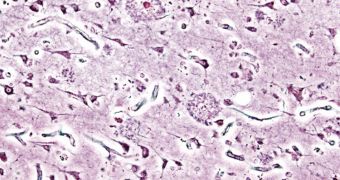According to the conclusions of a new study on the way Alzheimer's disease damages the human brain, it would appear that the condition triggers an infectious process of sorts, which researchers found to be eerily similar to the one employed by mad cow disease (MCD).
Scientifically known as bovine spongiform encephalopathy, MCD has significant side-effects on neural populations, just like Creutzfeldt-Jakob diseases. These are cataloged as infectious prion diseases, which means that they are caused by rogue proteins called prions.
What the experts discovered was that the way in which these diseases affect the brain is very similar to what happens in some Alzheimer's cases, raising some interesting questions about the very nature of this neurodegenerative form of dementia.
At first, it causes some mild cognitive impairment, including failures in attentiveness, planning, flexibility, and abstract thinking. More advanced stages lead to speech difficulties, losing the ability to read or write, mobility deteriorations, and then death.
“Our findings open the possibility that some of the sporadic Alzheimer’s cases may arise from an infectious process, which occurs with other neurological diseases such as mad cow and its human form, Creutzfeldt-Jakob disease,” explains Claudio Soto, PhD, quoted by PsychCentral.
The study researcher holds an appointment at the University of Texas Health Science Center in Houston, where the new study was conducted. Details of the work were published in the latest online issue of the esteemed journal Molecular Psychiatry.
“The underlying mechanism of Alzheimer’s disease is very similar to the prion diseases. It involves a normal protein that becomes misshapen and is able to spread by transforming good proteins to bad ones,” the expert adds.
“The bad proteins accumulate in the brain, forming plaque deposits that are believed to kill neuron cells in Alzheimer’s,” Soto adds. Beta amyloid proteins are the primary molecular actors in this diseases, since the form plaques between neurons that eventually destroy the nerve cells.
The tau protein was also discovered to play a significant role in damaging the brain. While the new study was only conducted on lab mice, researchers believe that its conclusions may be applied to humans as well.
“We took a normal mouse model that spontaneously does not develop any brain damage and injected a small amount of Alzheimer’s human brain tissue into the animal’s brain. The mouse developed Alzheimer’s over time and it spread to other portions of the brain,” Soto says.
“We are currently working on whether disease transmission can happen in real life under more natural routes of exposure,” he concludes.

 14 DAY TRIAL //
14 DAY TRIAL //